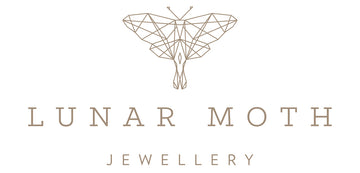Introduction
Welcome, dear readers, to a captivating journey that will take us through the annals of history, exploring the fascinating evolution of jewellery making. At Lunar Moth Jewellery, we're not just about creating beautiful pieces; we're about crafting wearable art that tells a story. Our dedicated sterling silver workshop in Nottingham, UK, serves as a modern-day sanctuary where traditional craftsmanship meets contemporary design. Here, we transform an array of materials into pieces that are not just beautiful but steeped in history and meaning.
The Significance of Materials in Jewellery Making
Before we delve into the fascinating journey of the evolution of jewellery making, it's essential to understand the significance of the materials used. From precious metals to gemstones, the choice of material has always been a crucial element in the art of crafting jewellery.
In ancient times, materials like bone, wood, and shells were commonly used. As civilisations progressed, the use of metals like copper, bronze, and eventually gold and silver became more prevalent. The choice of material often reflected not just the artisan's skill but also the cultural and symbolic importance of the piece.
Gemstones have also played a significant role in the history of jewellery making. Stones like lapis lazuli, emeralds, and sapphires have been used since ancient times, not just for their beauty but also for their supposed mystical properties
The Dawn of Jewellery Making: Prehistoric to Ancient Times
Jewellery has been a part of human culture for millennia, serving various purposes and meanings across different civilisations. In the earliest days, during prehistoric times, jewellery was far from the intricate designs we see today. People used whatever materials were readily available to them—shells, bones, and base metals—to create simple yet meaningful adornments. These pieces served primarily decorative purposes, adding a touch of personal flair to everyday attire.
As we moved into ancient times, the role of jewellery began to evolve significantly. No longer just decorative, these pieces started to bear symbolic motifs and became a status symbol among the elite. The materials also became more refined, moving from base metals to precious metals and stones. For instance, consider the Black Rutilated Spinel Gemstone Silver Ring from our collection. While it's a modern piece, its dark, mysterious gemstone and intricate setting echo the kinds of precious stones and metals that might have been used in ancient times to signify status or spiritual meaning
The Mystique of Medieval Jewellery
Let's take a moment to explore the mystique surrounding medieval jewellery. This period, spanning roughly from the 5th to the late 15th century, was a time of cultural upheaval and artistic innovation, which was reflected in the era's jewellery.
In medieval times, jewellery was more than just ornamentation; it was laden with symbolism and often served specific functions.
Rings could signify betrothal or alliance, while brooches and pins often had religious or heraldic meanings. Precious metals like gold and silver were commonly used, but less expensive materials like bronze and copper made jewellery accessible to various social classes.
Gemstones were also a significant component of medieval jewellery. Stones like garnets, sapphires, and pearls were not only prized for their beauty but also for their supposed mystical properties. For example, sapphires were believed to have healing powers and were often set in rings and amulets.
The Classical Eras: 14th to 17th Century
The period spanning the 14th to the 17th century was a transformative era in the realm of jewellery making. During these centuries, the craft evolved from being merely decorative to becoming a sophisticated form of artistry. Precious metals like gold and silver were no longer just materials; they became canvases for intricate designs and elaborate craftsmanship. The use of precious and coloured stones also became more prevalent, adding beauty and meaning to each piece.
Jewellery started to serve multiple purposes during this period. It was not just an accessory to be worn but a symbol of wealth, societal status, and even personal beliefs. Designs became more intricate, often influenced by mythological figures, celestial bodies, and even historical events. The art of jewellery-making became so refined that it was considered a skill set worthy of being passed down through generations.
One piece that beautifully encapsulates the essence of this transformative era is our Moonstone Stacking Ring Set. While this is a modern creation, its design elements harken back to the prevalent styles from the 14th to 17th centuries. The use of moonstone, with its ethereal glow and mystical properties, would have been highly prized in those times. The stacking design of the ring set allows for a level of customisation and individual expression that reflects the emerging focus on individualism in the jewellery style during these centuries.
The Age of Opulence: 18th and 19th Centuries
The 18th and 19th centuries stand as a golden era in the history of jewellery making, often referred to as the Age of Opulence. Unprecedented levels of creativity, innovation, and craftsmanship marked this period. Distinct styles like Art Nouveau and Art Deco emerged, revolutionising the way jewellery was designed and appreciated. These styles brought with them a new vocabulary of design elements—floral motifs, geometric patterns, and elaborate designs became the hallmark of this period.
Jewellery evolved to become more than just an accessory during these centuries; it became a statement piece, a reflection of one's personality, and even a marker of social standing. The pieces were so intricately designed that they were often considered works of art, worthy of being displayed in galleries. The craftsmanship was so refined that families would pass down these pieces as heirlooms, cherishing their material value and emotional and symbolic significance.
The use of coloured stones became more sophisticated during this period. Gemstones were carefully selected not just for their aesthetic appeal but also for their symbolic meanings. For example, sapphires often symbolised wisdom, while emeralds represented rebirth and love. The settings also became more intricate, often featuring complex patterns and designs that required high skill to execute.
A piece that perfectly embodies the spirit of the Age of Opulence is our Aquamarine Silver Ring. While this ring is a product of modern craftsmanship, its design elements are deeply rooted in the styles of the 18th and 19th centuries. The use of aquamarine, a gemstone known for its calming and soothing properties, would have been highly prized during these times. The intricate setting of the ring, featuring delicate patterns and designs, would have been considered a symbol of sophistication, elegance, and high social standing.
Cultural Influences on Jewellery Making Through the Ages
One of the most fascinating aspects of the evolution of jewellery making is the influence of various cultures and civilisations. From the ancient Greeks and Romans to the exotic lands of the East, different cultures have left their indelible marks on this art form.
In ancient Greece, jewellery was often inspired by mythological figures and stories. Pieces were crafted to represent gods and goddesses, and even everyday items like coins were used in jewellery to depict important cultural narratives. Fast forward to the Renaissance in Europe, where religious themes heavily influenced jewellery. Intricate pieces were crafted to tell biblical stories, often used as a form of devotion or as talismans for protection.
In Asia, particularly in countries like India and China, jewellery has always been deeply rooted in tradition and spirituality. In India, for example, jewellery is not just an accessory but an integral part of cultural rituals and ceremonies. In China, jade has been used for centuries for its beauty and supposed spiritual properties.
In the modern era, these cultural influences continue to play a significant role. Designers often draw inspiration from various cultures, blending traditional motifs with contemporary styles. For instance, our Moonstone Silver Necklace combines the modern aesthetic with the mystical allure of moonstone, a gemstone highly regarded in various cultures for its supposed healing properties.
The Modern Era: 20th to 21st Century
The 20th and 21st centuries have ushered in an era of unprecedented innovation and diversification in the world of jewellery. With the advent of new technologies, materials, and design philosophies, the boundaries of what is possible in jewellery design have expanded dramatically. This modern era has democratised the world of jewellery, making it more accessible and allowing people from all walks of life to enjoy the luxury and beauty of well-crafted pieces.
In this age of individualism, the role of jewellery has evolved significantly. It's no longer just a status symbol or a marker of wealth; it's a form of personal expression, a way for people to showcase their unique personalities and tastes. The designs have become more elaborate and intricate, often incorporating a variety of materials, from precious metals to synthetic gemstones, and techniques, from handcrafting to 3D printing.
One piece that beautifully encapsulates this modern approach to jewellery is our Labradorite Rosecut Hammered Sterling Stacking Ring. This ring is a testament to the possibilities of modern craftsmanship. Its elaborate setting and the use of labradorite—a stone known for its mystical properties—reflect the modern focus on individualism, personal expression, and the blending of traditional and contemporary techniques.
Technological Advancements in Jewellery Making
Another pivotal aspect of the evolution of jewellery-making is the role of technology. From the rudimentary tools of ancient civilisations to the high-tech equipment used today, technological advancements have continually shaped the way jewellery is made.
In the past, the process of crafting jewellery was labour-intensive and time-consuming. Artisans had to rely on simple tools and their own skills to carve, shape, and set stones. The introduction of machinery during the Industrial Revolution marked a significant turning point, allowing for mass production and more intricate designs.
Today, technology has taken jewellery-making to new heights. 3D printing, laser cutting, and computer-aided design (CAD) are just a few examples of how modern technology is revolutionising the industry. These advancements make the process more efficient and allow for unprecedented levels of detail and complexity.
For example, our Black Rutilated Spinel Gemstone Silver Ring showcases the kind of intricate detailing that modern technology allows. The gemstone setting and the overall design of the ring are crafted with a level of precision that would have been nearly impossible to achieve with traditional methods.
The Future of Jewellery Making
As we look towards the future, the realm of jewellery-making promises endless possibilities. Advancements in technology, such as 3D printing, synthetic gemstone creation, and even smart jewellery with embedded technology, point to a future that is as exciting as it is unpredictable. The focus will likely continue to be on individual expression but also on sustainability and ethical sourcing. As consumers become more conscious of the origins of their purchases, the industry will likely shift towards more responsible practices, ensuring that the art of jewellery-making continues to evolve in meaningful and ethical ways.
Conclusion
As we conclude this journey through the rich and varied history of jewellery making, it's evident that this art form has been, and will continue to be, an integral part of human culture and personal expression. We invite you to explore the diverse and exquisite collection at Lunar Moth Jewellery to find a piece that resonates with your own style and connects you to the long and fascinating history of this timeless craft.


